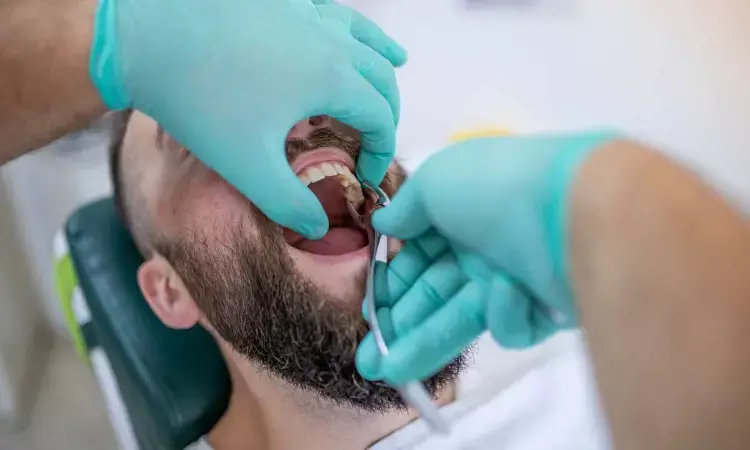- Home
- Medical news & Guidelines
- Anesthesiology
- Cardiology and CTVS
- Critical Care
- Dentistry
- Dermatology
- Diabetes and Endocrinology
- ENT
- Gastroenterology
- Medicine
- Nephrology
- Neurology
- Obstretics-Gynaecology
- Oncology
- Ophthalmology
- Orthopaedics
- Pediatrics-Neonatology
- Psychiatry
- Pulmonology
- Radiology
- Surgery
- Urology
- Laboratory Medicine
- Diet
- Nursing
- Paramedical
- Physiotherapy
- Health news
- Fact Check
- Bone Health Fact Check
- Brain Health Fact Check
- Cancer Related Fact Check
- Child Care Fact Check
- Dental and oral health fact check
- Diabetes and metabolic health fact check
- Diet and Nutrition Fact Check
- Eye and ENT Care Fact Check
- Fitness fact check
- Gut health fact check
- Heart health fact check
- Kidney health fact check
- Medical education fact check
- Men's health fact check
- Respiratory fact check
- Skin and hair care fact check
- Vaccine and Immunization fact check
- Women's health fact check
- AYUSH
- State News
- Andaman and Nicobar Islands
- Andhra Pradesh
- Arunachal Pradesh
- Assam
- Bihar
- Chandigarh
- Chattisgarh
- Dadra and Nagar Haveli
- Daman and Diu
- Delhi
- Goa
- Gujarat
- Haryana
- Himachal Pradesh
- Jammu & Kashmir
- Jharkhand
- Karnataka
- Kerala
- Ladakh
- Lakshadweep
- Madhya Pradesh
- Maharashtra
- Manipur
- Meghalaya
- Mizoram
- Nagaland
- Odisha
- Puducherry
- Punjab
- Rajasthan
- Sikkim
- Tamil Nadu
- Telangana
- Tripura
- Uttar Pradesh
- Uttrakhand
- West Bengal
- Medical Education
- Industry
Most effective pharmacologic treatment options for pain relief after tooth extraction

Canada: In people undergoing surgical tooth extractions, NSAIDs with or without acetaminophen lead to better pain-related outcomes than opioids with or without acetaminophen, except for acetaminophen 650 mg plus oxycodone 10 mg, or placebo, a recent study has shown. The study appears in the Journal of Dental Research.
Based on moderate and high certainty evidence, the study found that n individuals undergoing surgical tooth extractions, the interventions classified as the most effective for pain relief were ibuprofen 200-400 mg plus acetaminophen 500-1,000 mg, acetaminophen 650 mg plus oxycodone 10 mg, ibuprofen 400 mg, and naproxen 400-440 mg. Further, NSAIDs with or without acetaminophen result in better pain-related outcomes than opioids with or without acetaminophen (except acetaminophen 650 mg plus oxycodone 10 mg) or placebo.
The study compared the effectiveness of ten pharmacological interventions to develop guidelines for acute pain management after tooth extraction in adults.
North America is amid an opioid crisis, a leading public health and safety concern. In dentistry, many patients have prescribed opioids for the first time to manage acute postoperative pain after dental impaction surgery, which often results in the prescription of an excess number of opioid pills, thereby increasing the risk of misuse, abuse, and addiction. Of over half a million dental patient visits between 2011 and 2015, 29% of prescribed opioids exceeded the recommended morphine equivalent for appropriate acute pain management and over half exceeded the recommended days of supply.
The current clinical practice guidelines lack evidence-based guidance on effective management of acute dental pain. The National Academies’ report entitled “Framing Opioid Prescribing Guidelines for Acute Pain”, highlighted the need to formalize evidence-based alternatives to opioid analgesics in a clinical practice guideline.
The study by Anna Miroshnychenko from McMaster University Faculty of Health Sciences and colleagues involved systematic review (SR) and network meta-analysis (NMA) to assess the comparative effectiveness of ten different pharmacological interventions for the management of pain subsequent to simple and surgical tooth extraction, and pain associated with pulpitis or its complications.
This SR was conducted to inform the 2022 evidence-based clinical practice guidelines produced by the American Dental Association (ADA) Council on Scientific Affairs, the ADA Science & Research Institute (ADASRI) and the University of Pittsburgh’s and the University of Pennsylvania’s Schools of Dental Medicine in partnership with the United States Food and Drug Administration (FDA) for the management of acute dental pain.
Future research should focus on assessing ibuprofen 200 mg plus hydrocodone 5 mg, hydrocodone 5 mg plus acetaminophen 300-325 mg and tramadol 37.5 mg plus acetaminophen 325 mg through randomized clinical trials.
Reference:
Miroshnychenko A, Ibrahim S, Azab M, et al. Acute Postoperative Pain Due to Dental Extraction in the Adult Population: A Systematic Review and Network Meta-analysis. Journal of Dental Research. 2023;0(0). doi:10.1177/00220345221139230
Dr Kamal Kant Kohli-MBBS, DTCD- a chest specialist with more than 30 years of practice and a flair for writing clinical articles, Dr Kamal Kant Kohli joined Medical Dialogues as a Chief Editor of Medical News. Besides writing articles, as an editor, he proofreads and verifies all the medical content published on Medical Dialogues including those coming from journals, studies,medical conferences,guidelines etc. Email: drkohli@medicaldialogues.in. Contact no. 011-43720751


